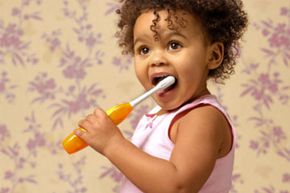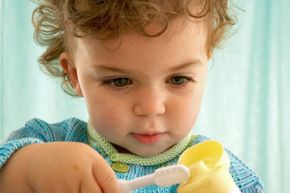"Brush thoroughly after meals or at least twice a day." Those simple instructions are familiar to anyone who has ever read the side of a tube of toothpaste, and most of us learned long ago that fluoride plays an essential role in building and keeping a set of strong, healthy teeth. But the same toothpaste label also tells us that children under 2 years of age should use fluoride toothpaste only under the advice of a dentist or physician, and children under 6 should be supervised closely when they brush. So what exactly is fluoride, and why the warnings about using it for young children?
Fluoride is a natural mineral found abundantly in water, soil and rocks throughout the Earth's crust. Fluoride is a chemical ion of the element fluorine, meaning simply that it has one extra electron that gives it a negative charge [sources: Colgate; Crosta]. If you check the toothpaste label one more time, you'll see that fluoride appears not on its own, but in one of the three compounds approved by the U.S. Food and Drug Administration for use in toothpaste: stannous fluoride (a compound containing fluoride and the element tin), sodium fluoride (a compound containing fluoride and sodium) and sodium monofluorophosphate, which is derived from sodium fluoride [sources: McCoy; Tom's of Maine].
Advertisement
The fluoride in toothpaste helps to prevent tooth decay and cavities in two ways: First, it prevents the bacteria in plaque from forming acids that erode the tooth enamel and cause decay. Second, in areas of the teeth that have already been damaged by acids, fluoride builds up in the weakened areas and begins to strengthen, or remineralize, the teeth [sources: Crosta; McCoy].
So when is it safe for toddlers to use fluoride toothpaste? As you may have read on the label (or heard from your dentist or pediatrician), the American Dental Association (ADA) recommends only non-fluoride toothpastes for kids younger than the age of 2 [source: American Dental Association]. But does turning 2 mean your child is automatically ready to use the big-kid stuff? Read on to learn about the risks of ingesting too much fluoride and signs that your toddler is ready to brush with fluoride toothpaste.
Advertisement

